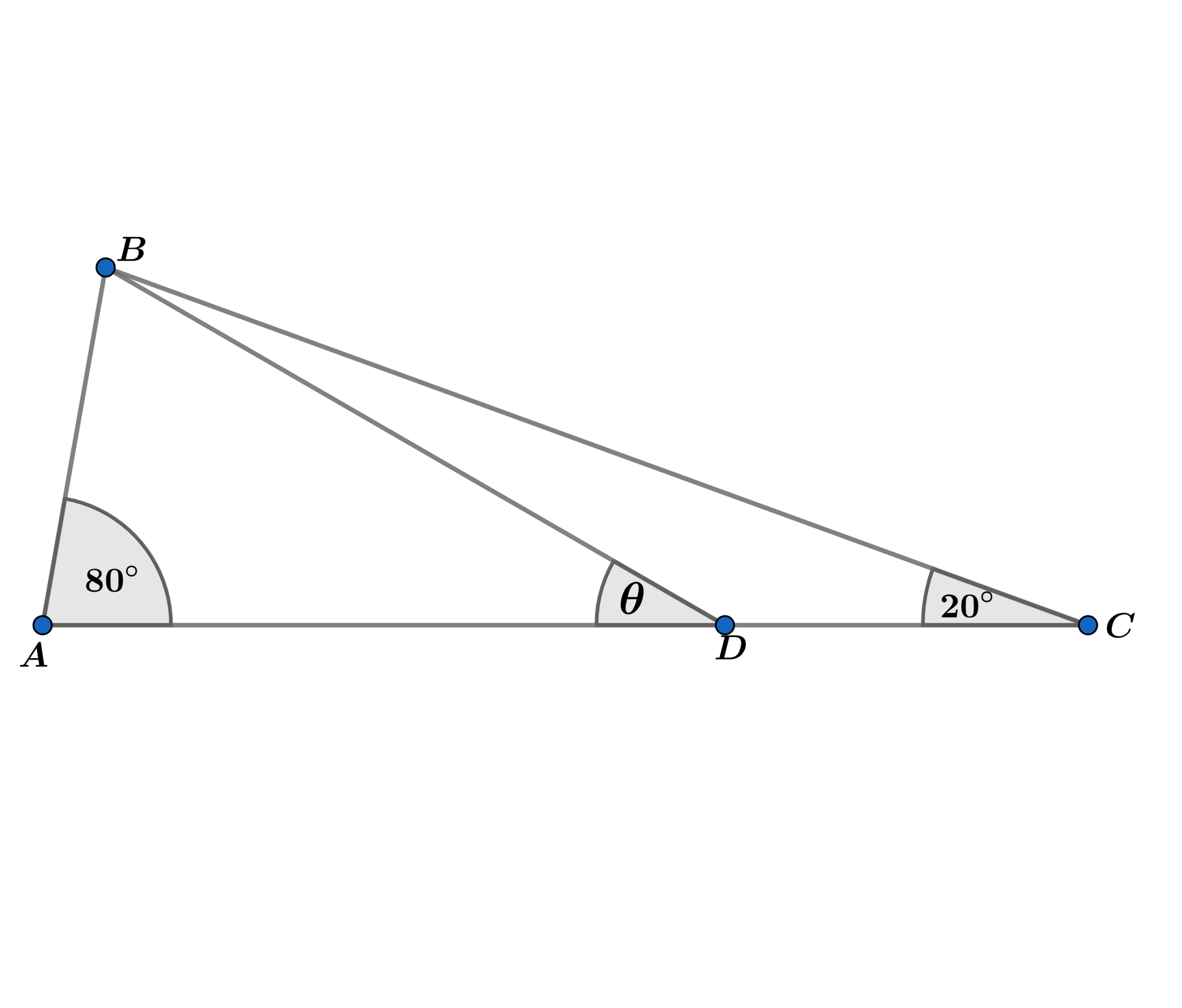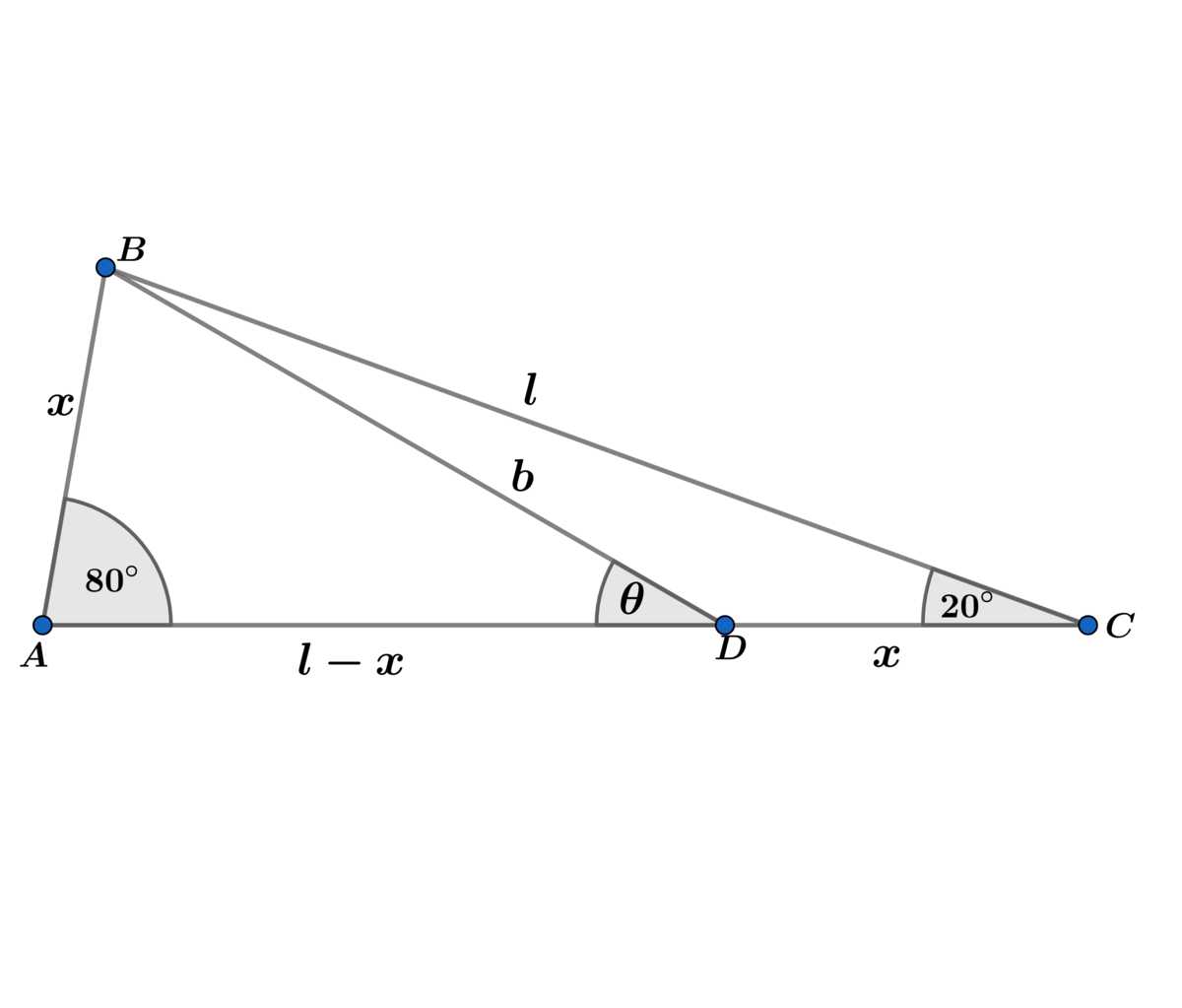It's All Angles !

In the diagram above, A B ≅ C D and m ∠ A = 8 0 ∘ and m ∠ C = 2 0 ∘ .
Find m ∠ B D A = θ (in degrees).
The answer is 30.
This section requires Javascript.
You are seeing this because something didn't load right. We suggest you, (a) try
refreshing the page, (b) enabling javascript if it is disabled on your browser and,
finally, (c)
loading the
non-javascript version of this page
. We're sorry about the hassle.
2 solutions

Using the law of cosines on △ A B C with included angle C we obtain:
x 2 = 2 l 2 ( 1 − cos ( 2 0 ∘ ) ) = 4 l 2 sin 2 ( 1 0 ∘ ) ⟹ x = 2 l sin ( 1 0 ∘ )
Using the law of cosines on △ B C D with included angle C we obtain:
b 2 = l 2 ( 1 + 4 sin 2 ( 1 0 ∘ ) − 4 sin ( 1 0 ∘ ) cos ( 2 0 ∘ ) )
Using law of sines on △ A B D we obtain:
sin ( θ ) 2 l sin ( 1 0 ∘ ) = sin ( 8 0 ∘ ) b ⟹ b = sin ( θ ) 2 l sin ( 1 0 ∘ ) sin ( 8 0 ∘ ) ⟹
b 2 = sin 2 ( θ ) 4 l 2 sin 2 ( 1 0 ∘ ) sin 2 ( 8 0 ∘ ) ⟹
sin 2 ( θ ) 4 sin 2 ( 1 0 ∘ ) sin 2 ( 8 0 ∘ ) = 1 + 4 sin 2 ( 1 0 ∘ ) − 4 sin ( 1 0 ∘ ) cos ( 2 0 ∘ ) ⟹
sin 2 ( θ ) = 1 + 4 sin 2 ( 1 0 ∘ ) − 4 sin ( 1 0 ∘ ) cos ( 2 0 ∘ ) 4 sin 2 ( 1 0 ∘ ) sin 2 ( 8 0 ∘ ) ⟹
sin ( θ ) = 1 + 4 sin 2 ( 1 0 ∘ ) − 4 sin ( 1 0 ∘ ) cos ( 2 0 ∘ ) 2 sin ( 1 0 ∘ ) sin ( 8 0 ∘ ) =
1 + 4 sin 2 ( 1 0 ∘ ) − 4 sin ( 1 0 ∘ ) cos ( 2 0 ∘ ) sin ( 2 0 ∘ ) = 0 . 5 ⟹ θ = 3 0 ∘
Let ∣ A B ∣ = ∣ C D ∣ = x , ∣ B D ∣ = y . Then
sin θ x = sin 8 0 ° y ⟹ y x = sin 8 0 ° sin θ , sin ( θ − 2 0 ° ) x = sin 2 0 ° y ⟹ y x = sin 2 0 ° sin ( θ − 2 0 ° ) . This implies sin θ sin 2 0 ° = sin ( θ − 2 0 ° ) sin 8 0 ° ⟹ θ = tan − 1 ( cos 2 0 ° sin 8 0 ° − sin 2 0 ° sin 2 0 ° sin 8 0 ° ) = 3 0 ° .